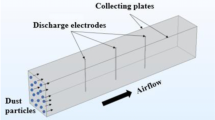Abstract
Identification of the optimal operating conditions and evaluation of their robustness are critical issues for industrial processes. A standard procedure, for modelling a laboratory-scale wire-to-cylinder electrostatic precipitator and for guiding the research of the set point, is presented. The procedure consists of formulating a set of recommendations regarding the choice of parameter values for electrostatic precipitation. The experiments were carried out on a laboratory cylindrical precipitator, built by one of the authors, with samples of wood particles. The parameters considered are the applied high voltage U, the air flow F, and the quantity of dust in air m. Several “one-factor-at-a-time” followed by factorial composite design experiments were performed, based on the following three-step strategy: 1) Identify the domain of variation of the variables; 2) Determine the mathematical model of the process outcome; 3) Validation of the mathematical model and optimisation of the process.
Similar content being viewed by others
References
White H J. Industrial Electrostatic Precipitation. MA: Addition-Wesley, 1963
McLean K J. Electrostatic precipitators. IEE Proceedings A, 1988, 135(6): 347–361
Gu Z, Schill Jr R A. Novel quasi-electrostatic air filter: a single-particle study 1. Journal of Electrostatics, 1997, 39(3): 203–230
Navarrete B, Cañadas L, Cortés V, et al. Influence of plate spacing and ash resistivity on the efficiency of electrostatic precipitators. Journal of Electrostatics, 1997, 39(1): 65–81
Takahashi T, Zukeran A, Ehara Y, et al. Influence of reentrainment phenomena on particle deposit in electrostatic precipitator. Transactions of the Institute of Electrical Engineers of Japan, 1999, 119-A(3): 254–260
Parker K R. Effective capture of respirable-sized particulates using electrostatic precipitator technology. The IEE Engineering Science and Education Journal, February 2000, 9(2): 33–40
Brocilo D, Chang J S, Findlay R D. Modeling of electrode geometry effects on dust collection efficiency of wire-plate electrostatic precipitator. The 8th International Conference on Electrostatic Precipitation, Birmingham, Alabama, USA. 2001, 1–18
Liang X, Jayaram S, Berezin A, et al. Modelling of the electrical parameters of a wire-cylinder electrostatic precipitator under pulse energization. IEEE Transactions on Industry Applications 2002, 38(1): 35–42
Schmid H J. On the modelling of the particle dynamics in electro-hydrodynamic flow fields: II. influences of inhomogeneities on electrostatic precipitation. Powder Technology, 2003, 135/136: 136–149
Kogelschatz D U, Gerteisen E A. Advanced computer modelling of electrostatic precipitators. Filtration and Separation, 2001, 38(9): 32–37
Talaie M R, Taheri M, Fathikaljahi J. A new method to evaluate the voltage-current characteristics applicable for a single-stage electrostatic precipitator. Journal of Electrostatics, 2001, 53(3): 221–233
Talaie M R. Mathematical modeling of wire-duct single-stage electrostatic precipitators. Journal of Hazardous Materials, 2005, B144: 44–52
Rajanikanth B S, Prabhakar B R. Modeling of prebreakdown VI characteristics of a wire-plate electrostatic precipitator operating under combined dc-pulse energization. IEEE Transactions on Dielectrics and Electrical Insulation, 1994, 1(6): 1058–1067
Frigon N L, Mathews D. Practical Guide to Experimental Design. New York: Wiley, 1996
Hicks C R, Turner Jr K V. Fundamental Concepts in the Design of Experiments. New York: Oxford University Press, 1999
Eriksson L, Johansson E, Kettaneh-Wold N, et al. Design of Experiments, Principles and Applications. Umeå, Sweden: Umetrics, 2000
Medles K, Tilmatine A, Miloua F, et al. Set point identification and robustness testing of electrostatic separation processes. IEEE Transactions on Industry Applications, 2007, 43(3): 618–626
Dascalescu L, Tilmatine A, Aman F, et al. Optimisation of electrostatic separation processes using response surface modeling. IEEE Transactions on Industry Applications. 2004, 40(1): 53–59
Author information
Authors and Affiliations
Corresponding author
About this article
Cite this article
Tilmatine, A., Brahami, M., Miloua, F. et al. Using experimental designs for modelling of intermittent air filtration process. Front. Electr. Electron. Eng. Ch 3, 218–222 (2008). https://doi.org/10.1007/s11460-008-0040-4
Received:
Accepted:
Published:
Issue Date:
DOI: https://doi.org/10.1007/s11460-008-0040-4




